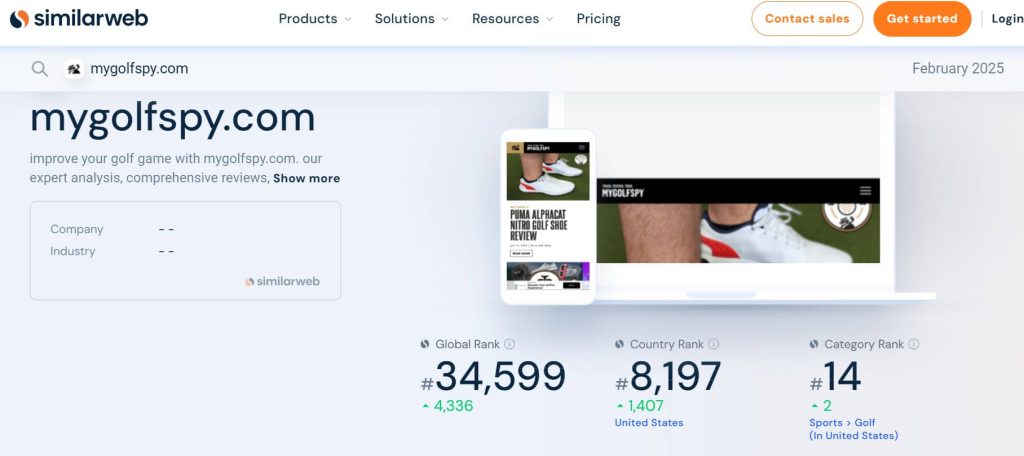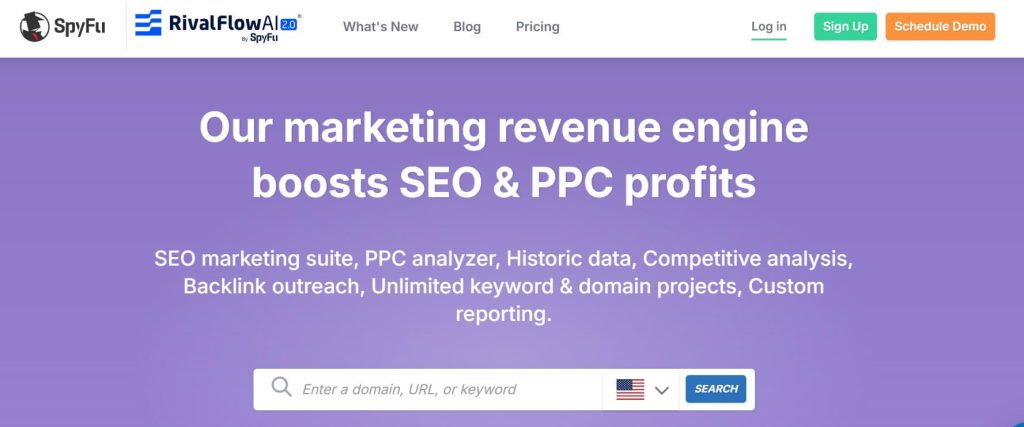In affiliate marketing, it’s crucial to understand how your competitors operate and what sets them apart. Affiliate marketing competition analysis allows you to evaluate your rivals’ strategies, discover growth opportunities, and pinpoint areas where you can improve your offerings.
In this guide, we’ll walk you through the essential steps of affiliate marketing competition analysis and introduce powerful tools that helps!

Step-by-step guide to affiliate marketing competition analysis
Here are steps to analyze competitors of your brands when running an affiliate program. You may care about strategies to find affiliates online (of your competitors)
Step 1: Identify competitors
Before analyzing the affiliates of the competitors, it’s important to first identify who your direct and indirect competitors are. This distinction will help you understand which businesses and affiliate models are truly relevant to your own, giving you a clearer view of where to focus your analysis.
Direct competitors
Direct competitors are businesses in your niche that are running affiliate marketing campaigns. These are companies that offer similar products or services and target the same customer base.
For example, if you run a Shopify store selling handmade jewelry, your direct competitors would be other jewelry brands that also rely on affiliate marketing to generate traffic and sales.
Indirect Competitors
Indirect competitors, on the other hand, are brands that are targeting the same audience but may not be selling identical products. This mean their affiliates are likely able to promote YOUR PRODUCTS besides of the current ones in their portfolio.
For instance, if you sell skincare products, your indirect competitors might include beauty and wellness brands that offer related services or products, even if they don’t directly overlap with your product offering.
Tools for identifying competitors
To identify your direct and indirect competitors, you can use various tools that provide insights into top-ranking affiliate programs within your niche. Some useful platforms include:
- SEMrush: Use this tool to conduct competitive research by entering your website or a competitor’s website to identify top competitors, keywords, and traffic sources.
- Ahrefs: Another great SEO tool for competitor analysis. Ahrefs allows you to analyze backlinks and top-ranking pages, helping you discover which affiliate programs and competitors are driving the most traffic in your niche.
- Google Search: Simply entering keywords related to your product or service can help you identify the top affiliate programs in your industry. Searching for terms like “best affiliate programs for fitness products” or “coffee affiliate programs” will show you websites that are leading the pack.

By identifying both your direct and indirect competitors, you’ll be equipped with the knowledge to analyze their affiliate marketing strategies, assess their performance, and identify opportunities to differentiate your program.
Step 2: Analyze Competitors’ Affiliate Program
Once you’ve identified your competitors, the next step is to analyze their affiliate programs in detail. This process involves digging into their
- their commissionable products
- affiliate offerings (such as commission structures, rewards, samples, tools, payment methods)
- terms and conditions
Commissionable products
These are products or services that affiliates can earn a commission on when they drive a sale. Not all products in a store may be eligible for commissions, so knowing what’s commissionable helps affiliates and brands strategize better.
For competitors that prefer a simple approach, they might set a flat commission rate based on the order value (e.g., 10% per sale). However, as a brand grows, its commission structure often becomes more complex. For example, Amazon uses a category-based system where different product types have different commission rate.
Some products attract more affiliate promotions than others. Factors that make a product successful include:
- High demand: Products that sell well naturally get more affiliate attention (e.g. more posts)
- Recurring revenue potential – Subscription-based products (e.g., Skillshare) are appealing because affiliates can earn for longer periods.
The nature of products can make it easier to market than others. Skillshare sells just one product (unlimited learning access), but it offers multiple ways to promote it (e.g., free trials, discounts, exclusive content). Meanwhile, Udemy (which allow students to purchase individual courses) offer a lot of supports to teachers who promote their course.
Commission structure
One of the first things you should analyze is the commission structure of your competitors’ affiliate programs. This includes whether they offer fixed fees or percentage-based commissions, and how their rates compare to yours. High commissions can incentivize affiliates to promote a program more aggressively, while low rates may drive affiliates to seek other opportunities.
For example, if you’re offering a 10% commission for every sale, but your competitor is offering 20%, affiliates may be more inclined to promote their products over yours. You can also observe if competitors offer tiered commission structures, where affiliates can earn higher rates as they generate more sales or flat-rate commissions.
Related: 3 simple affiliate commission structure (SMEs only).
Affiliate tools
The tools that competitors offer to their affiliates can play a significant role in the success of their programs. Look for features like custom affiliate links, reporting dashboards, and creative resources such as banners, ads, and email templates. These tools can streamline an affiliate’s workflow, enhance their promotional efforts, and increase the chances of conversions.
Are they offering any unique features like custom tracking links for specific campaigns or more detailed performance reporting? These elements can provide affiliates with more control over their promotions and give them the insight they need to improve their results.
If your program lacks these tools and features, affiliates might find it difficult to track their progress or effectively promote your products, leading them to seek more supportive programs elsewhere.
Payment methods
Different affiliate programs use different payment methods, such as PayPal, bank transfers, or store credit.
There are something to notice at this step:
- Do your competitors pay with store credit, coupons or alternative gift codes? If they did, it means that there are a part of their affiliate team are existing customer or locating nearby. This also means they may be running an CRM system or tapping into the loyal customer base.
- Do they use international cash transaction platform like PayPal? Despite the fact that PayPal is one of the most popular payment method, some advertisers may deny to use it (as it may complicate their accounting cycles) and simply focus on recruiting domestic affiliates. In developed affiliate marketing market such as US, this choice means they may have missed a lot of international affiliates. There are a lot of high-skilled affiliates from developing countries (i.e. Philippines or India) targeting such markets, looking for a suitable brands and they literally can drive an insane amount of traffic to your store.

Terms and conditions
The terms and conditions of an affiliate program can significantly impact both your affiliates and your business.
Analyze your competitors’ restrictions, such as whether they have:
- geographic limitations (e.g. some brands restrict SEA countries to reduce fraud risks)
- exclusive agreements (e.g. affiliates are not allowed to work with competitors)
- rules around affiliate promotions (e.g. affiliate HAVE to include affiliate hashtags in their social promotion)
- incentives they offer (e.g. rewards for top performers or bonuses)
A competitor’s program might have strict rules about how affiliates can advertise, limiting the types of content or platforms they can use. On the other hand, they might offer performance-based incentives, such as additional bonuses for affiliates who hit specific sales milestones within a quarter.
By this way, you can benchmark your own offering and identify opportunities to provide more value to potential affiliates!

Step 3: Examine affiliate management tools
Understanding how your competitors manage their affiliate programs is crucial in identifying potential improvements for your program. In this section, we will analyze the tools and strategies competitors use to recruit and manage affiliates!
But, please not that this may be a time consuming stage while result less than expected!
Affiliate networks or software
Many competitors choose to manage their affiliate programs through affiliate networks or dedicated software solutions.
These networks offer a centralized platform where affiliates can sign up, access promotional materials, track their performance, and receive payments. Some of the most popular affiliate networks include Impact, CJ Affiliate, and ShareASale, which provide a robust set of tools for both merchants and affiliates.
Many affiliate networks allow only passive recruitment, meaning affiliates must apply to join your program rather than actively seeking them out. This can limit your ability to handpick affiliates who perfectly match your brand but still provide a large pool of affiliates who actively engage with the network and are looking for new opportunities.
Additionally, some businesses use dedicated affiliate management software (e.g. BixGrow) that allows them more control and flexibility in managing their affiliates without being tied to a specific network. These platforms can help streamline everything from recruitment to payment processing.
Affiliate recruitment strategy
An essential part of affiliate management is recruitment. The most successful affiliate programs have clear targeted strategies for attracting high-quality affiliates.
For examples, Gymshark prefer social media personalities than bloggers, and they don’t accept nano or micro influencers.
In terms of affiliate marketplace, some competitors may focus on (actively) reaching out to influencers, bloggers, or content creators in their niche, while others may use networks or marketplaces that allow for passive recruitment.

Step 4: Review competitor affiliate marketing strategy
To understand how your competitors attract affiliates and drive conversions, you need to examine their marketing strategies. This analysis involves looking at the channels they use to promote their affiliate programs, the types of content they create, and the incentives they offer to encourage affiliates to join and perform.
Channels for affiliate promotion
First, take note of the marketing channels your competitors use to promote their affiliate programs.
- Email marketing: Many businesses use email campaigns to directly reach potential affiliates. These emails may include program details, commission structures, and an invitation to join the affiliate network.
- Social media: Promoting affiliate programs via social media channels such as Instagram, Twitter, LinkedIn, or Facebook is another popular method. Competitors may post about their affiliate programs in a way that resonates with influencers or micro-influencers in their industry.
- Content marketing: Some competitors may create blog posts, videos, or podcasts discussing the benefits of becoming an affiliate, providing valuable insights into the program, and encouraging sign-ups.
By evaluating which channels your competitors prioritize, you can decide where to focus your promotional efforts. For instance, if your competitors are heavily promoting their programs on Instagram and getting strong results, it might be worthwhile to invest in building a social media strategy for your affiliate program.
Content
Next, take a close look at the type of content your competitors create to promote their affiliate programs. This can include everything from landing pages to call-to-action buttons, banners, and email templates.
- Calls to action: How compelling are their calls to action (CTAs)? Are they using strong language that encourages potential affiliates to sign up right away? Look at the copy to see how they emphasize the benefits of joining the program (e.g., high commissions, exclusive rewards, or free tools).
- Landing pages: Review their affiliate program landing pages for clarity, design, and the value proposition they offer affiliates. Is the page easy to navigate? Does it provide clear information about commissions, payment methods, and terms?
- Promotional copy: Analyze the tone and messaging of their promotional copy. Are they focusing on the financial rewards of being an affiliate? Or do they highlight other benefits, such as being part of a community, gaining access to exclusive content, or receiving marketing resources?

Incentives for affiliates
Finally, analyze the incentives your competitors offer to attract high-quality affiliates and encourage them to perform at their best.
- Bonuses for new affiliates: Many programs offer a sign-up bonus or a higher commission rate for new affiliates who generate sales within a certain time frame.
- Tiered commission Structures: Some programs implement tiered commissions, where affiliates earn higher percentages as they generate more sales or refer more customers.
- Exclusive promotions: Offering exclusive deals, such as special discount codes for affiliates to share with their audiences, can increase the appeal of your program.
By studying how your competitors structure these incentives, you can create a more attractive and competitive program.

Step 5: Analyze competiors’ affiliate marketing performance
Once you’ve identified your competitors and examined their affiliate programs, the next step is to evaluate how well their affiliate marketing efforts are performing. This step is crucial because understanding your competitors’ performance will help you set benchmarks for your program and highlight areas where you can gain a competitive edge.
Website traffic and affiliate links
One of the most effective ways to gauge your competitors’ affiliate performance is by analyzing their website traffic, specifically the traffic that is coming from affiliate links. This will give you insight into how well their affiliates are driving visitors to their site and how effectively they are converting those visitors into customers.
SimilarWeb, Ahrefs, and SEMrush can help you estimate traffic coming from affiliate links. These tools provide data on the top referral sources for your competitors’ websites, helping you identify which affiliates are generating the most traffic.
You should identify any spikes in traffic that could be tied to successful affiliate campaigns. You can also monitor any changes in referral sources over time to see if there’s a consistent group of affiliates driving traffic or if they’re using new affiliates to test different strategies.

Search rankings and affiliate keywords
Search engine rankings are another useful indicator of affiliate marketing performance. When affiliates link to your competitors, those links often boost the target page’s SEO performance, leading to higher rankings for competitive keywords.
SEMrush and Ahrefs can help you identify the keywords driving organic traffic to competitors’ affiliate landing pages and content.
Monitor which affiliate-related keywords your competitors are ranking for. Are they ranking for long-tail keywords related to affiliate programs, such as “best affiliate programs for fitness bloggers”? This can give you an idea of what types of affiliates they are attracting, as well as which keywords are most effective in driving traffic.
Affiliate retention and loyalty
Analyzing affiliate retention is a crucial aspect of understanding the long-term success of your competitors’ affiliate marketing efforts. High retention rates indicate that affiliates are satisfied with their program and are continuing to generate sales over time. Low retention might suggest issues with the program, such as uncompetitive commission rates, lack of support, or poor tracking tools.
Check for patterns in recurring affiliate content, such as blog posts or social media mentions, which can indicate that certain affiliates are sticking with the program and driving consistent traffic. If a competitor’s affiliate program has few affiliates but they stay for a long period, this may indicate a highly selective, high-performing program.
Track affiliate sales and conversion rates
While tracking individual affiliate sales is generally private information, you can still estimate how well competitors are converting affiliate traffic into sales by looking at overall conversion trends and marketing tactics.
SpyFu can offer insight into traffic behavior on your competitors’ websites. If certain landing pages or promotions drive more traffic during affiliate marketing campaigns, this can indicate better conversion rates.
Investigate which types of products or offers affiliates are promoting. Are these high-conversion products? Are there seasonal trends in affiliate performance?
Step 6: Develop your competitive edge
After thoroughly done your research on competitor analysis affiliate marketing, it’s time to leverage your findings and develop a strategy that sets your program apart. This step is about identifying areas where your competitors fall short & optimizing your own affiliate program to outperform them.
Optimize the onboarding experience
One area where many affiliate programs failed at is the onboarding process. If competitors have complicated or slow onboarding procedures, you can capitalize on this by streamlining and simplifying yours. A smooth onboarding experience helps affiliates get started quickly, reducing friction and increasing the likelihood of long-term collaboration.
Make sure your affiliate registration is easy, intuitive, and quick. Offer helpful resources, such as step-by-step guides and videos, to help affiliates understand the program and how to start earning commissions.
Personalize the affiliate experience
Personalization is key to building strong, lasting relationships with affiliates. While your competitors may offer basic support, go the extra mile to make your affiliates feel valued and appreciated. Offer personalized resources, such as tailored marketing materials, exclusive promotional offers, and one-on-one communication.
Use data and affiliate preferences to create customized outreach. Recognize top performers and offer them unique rewards or opportunities. This will make them feel more connected to your brand and encourage them to promote your products with greater enthusiasm.
Focus on underserved niches
While your competitors might be focusing on broad or saturated markets, look for opportunities in underserved niches that could be highly profitable. By narrowing your target audience and focusing on niche markets, you can attract affiliates who specialize in these areas and are more likely to produce better results.
Research gaps in the market that your competitors aren’t addressing. Identify niche products or audiences that would benefit from affiliate marketing partnerships and target influencers or content creators who focus on those areas.
Build strong relationships with affiliates

Strong affiliate relationships are crucial to long-term success. Many programs focus solely on acquiring affiliates but fail to maintain solid communication and ongoing support. By offering regular updates, personalized feedback, and responsive support, you can foster loyalty and turn your affiliates into long-term partners.
Stay in touch with affiliates regularly through email or meetings. Offer them insights into their performance and provide constructive feedback. Being proactive in communication and showing appreciation for their efforts will help you retain top affiliates.
Best tools to use for affiliate marketing competition analysis
To effectively analyze your competitors and gain insights into their affiliate marketing strategies, you need the right tools. These tools help you track competitor performance, identify affiliate networks, and uncover successful marketing tactics.
SimilarWeb

SimilarWeb rovides insights into website traffic, audience demographics, and referral sources.
SimilarWeb allows you to analyze your competitors’ websites and uncover where their affiliate traffic is coming from. You can also examine their audience interests and behaviors, giving you a better understanding of what kind of affiliates might be driving traffic to their site. This can help you identify high-performing affiliates and affiliate strategies you might want to replicate or improve.
For example, if you’re running a fashion eCommerce site, SimilarWeb can help you track which affiliate networks or influencers are driving the most traffic to your competitor’s fashion blog or online store.
Ahrefs

It’s a powerful SEO tool that analyzes backlinks, keyword rankings, and competitor websites.
Ahrefs allows you to monitor competitors’ backlink profiles to see where they are getting traffic from and which affiliate sites are linking to them. You can also track the keywords that competitors are ranking for in search engines and identify affiliate keywords that they are targeting to attract potential affiliates.
You can use Ahrefs to identify which affiliate blogs or influencers are linking to your competitors and what types of keywords they are ranking for, which can help you find similar opportunities to target for your own affiliate program.
SpyFu

SpyFu can track competitors’ paid and organic search strategies.
It gives you access to your competitors’ paid and organic keyword strategies, including the keywords that are most profitable for them. By understanding which terms competitors are bidding on and ranking for, you can identify key opportunities for affiliate marketing content and partnerships, as well as spot potential affiliate keywords they may be targeting.
BuzzSumo

BuzzSumo – a content research tool to discover top-performing content across social platforms.
BuzzSumo helps you find the most shared and engaging affiliate content in your industry. By analyzing the content that competitors are creating, you can spot trends and identify which types of promotional tactics or affiliate-driven content resonate most with your target audience. You can also uncover affiliate promotions or partnerships that are receiving the most traction.
SEMrush

This is a comprehensive digital marketing suite that tracks competitors’ keyword rankings, backlinks, and affiliate-related strategies.
SEMrush allows you to analyze competitors’ affiliate-related keywords, monitor backlink profiles, and track the overall SEO health of their websites. You can use this information to uncover affiliate sites that are linking to your competitors and identify successful content or landing pages that affiliates are promoting.
Wrap it up
Affiliate marketing competition analysis is a crucial step for businesses looking to scale and optimize their affiliate programs. By understanding your competitors, both direct and indirect – you can gain valuable insights into their affiliate strategies, commission structures, and marketing tactics. This knowledge allows you to fine-tune your program, identify gaps, and implement strategies that will help you attract high-quality affiliates and drive better results.
Ultimately, the goal of competitive analysis isn’t to copy what others are doing but to understand their strengths and weaknesses, enabling you to carve out your own niche and stay ahead in the market. With the right approach, you can enhance your affiliate program, attract top affiliates, and boost your brand’s success in a competitive online environment.